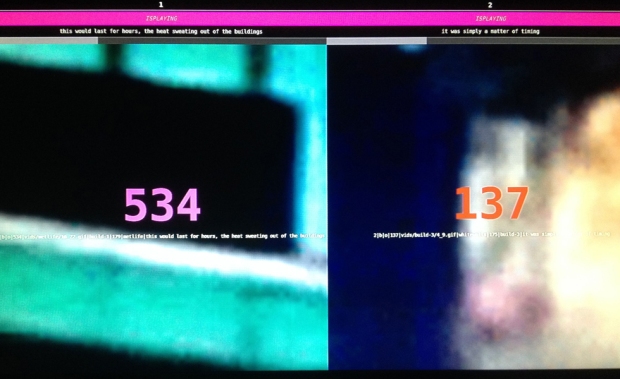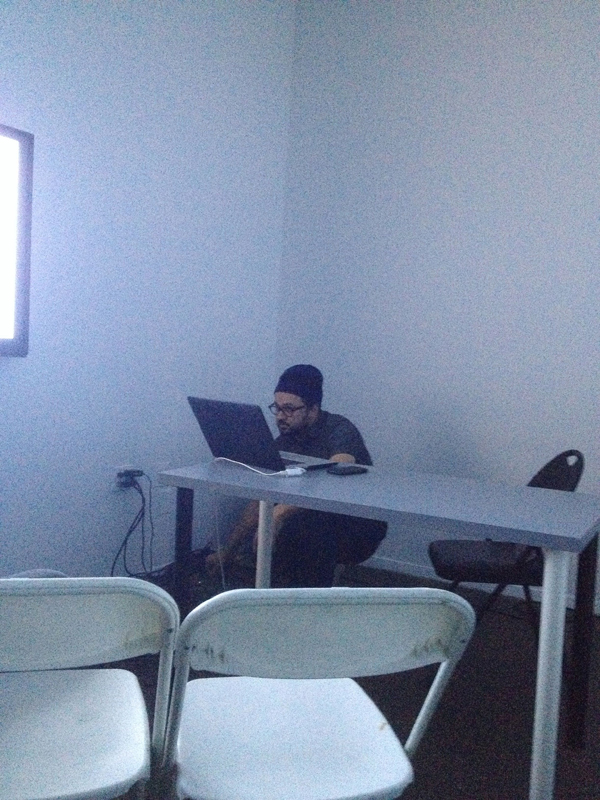Review: Code and Language in DataSpaceTime’s “Thresholds”
written by Conor O’Brien, The Living Gallery
Microscope Gallery co-founder Elle Burchill said of the people who’ve seen the gallery’s current exhibition, “Thresholds” by DataSpaceTime duo Ray Sweeten and Lisa Gwilliam, those who seemed to respond most enthusiastically to the work were the poets who read at the gallery’s recent poetry event.
Poetry uses language in a particular way. It is about association more than point-making. A word does not only signify: it has a sound, a shape, and a web of connotations and image-inducing capabilities aside from whatever its standardized definition may be. Language, of course, is not limited to words. Language informs how we think and, by extension, what we think. If we only “read” a certain way then we will only think a certain way, and will only think certain things. Poets often play with language in order to elucidate language’s relationship with thought, and how people’s ways of thinking can be manipulated by language.
DataSpaceTime’s installation consists of four screens that operate on four different browsers which send information to each other, and respond accordingly, using “web-chat technology.”
Two of the screens are separated into grids that play a series of image gifs. At times the gifs work together to form a larger, coherent moving image (aerial view of a street, the top of an escalator, panning view of a graffitied wall at night), at other times the gifs off-set the larger image into abstraction. These screens sometimes resemble a digital tapestry, the motion of the gifs often suggest weaving.
The two other screens, a smaller one to the left of the center screens on the same wall and another screen on the opposite wall, show a visual decomposition of the information being sent to the center screens. The smaller screen breaks down the image gifs being fed to the center screens. The other screen is similar in size and grid-structure to the two center screens, but instead of images of urban scenery, this screen displays a page of distorted text under the image of a magnifying glass. The press release reveals this text to be the code the artists wrote to run the piece.
The code is not hidden; it is aestheticized and incorporated into the piece. This can be framed in a poetry context, as a poetic use of this language. The language of computer programming is both ubiquitous and invisible in the internet age, and only a relative minority of people can “read” it or understand its rules. The piece reveals how text informs image informs text: the language of computer code influences the images as they appear on screen, manipulating and distorting them, while the text of the code itself also becomes an image that is manipulated.
DataSpaceTime’s Ray Sweeten performed during the Microscope Gallery’s “Listening Party.” During the event he premiered what he described as two unfinished “sketches,” using the same technology as the “Thresholds” to allow the browsers send and respond not only to gifs, but also different sounds, creating audio compositions that correspond to the visual ones.
Before beginning the second sketch, Sweetey opened up a computer file in order to put finishing touches on the program’s code, explaining to the audience that he needed to “pull back the curtain for a second.” The effect is that of making the audience aware of the language behind the experience of the piece. It is a comment on language, a breaking down of text, image, and sound, and the relationship of language to experience. There is a sense that our experience, the sounds we hear and images we see, can be manipulated not only by the languages we can “read,” but perhaps even more so by those we can not, such as the language of computer code. Our everyday experience is similarly manipulated by the ways we can or cannot “read” it. DataSpaceTime is interested not only in creating the experience, but allowing the mechanics that inform the experience to be unveiled and incorporated into it.
For more information about this show visit the gallery’s page
or check out their Facebook Event. The show runs through December 1st.









